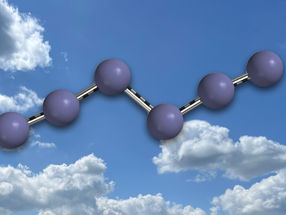Organic Hydrogen Storage
Microporous polymers made of fused hydrocarbon rings can adsorb hydrogen
Fossil fuels are limited and polluting, hence the search for alternatives. One suitable and environmentally sound fuel would be hydrogen; unfortunately there are currently few technical possibilities for the construction of safe and efficient hydrogen storage tanks that are suitable for cars. One possible solution to the hydrogen storage problem is to use microporous materials such as zeolites or activated carbons, which have many molecular sizes holes suitable for the containment of hydrogen and can also release it when needed.
Neil McKeown, of Cardiff University, UK, and his collaborators, Peter Budd (University of Manchester) and David Book (University of Birmingham) have chosen a new approach: they have developed a purely organic polymer that can adsorb appreciable quantities of hydrogen.
The molecular chains in most organic polymers are so flexible that they can form tightly packed structures. This means there are no cavities inside, and thus no appreciable internal surface onto which substances could be adsorbed. The chemists thus constructed polymers from interlinked five- and six-membered rings. At defined points in the molecule, two five-membered rings are connected in such a way as to provide a contorted shape to the stiff macromolecular structures. The contorted molecules cannot pack together efficiently and leave gaps and interstices. These "polymers of intrinsic microporosity" (PIMs) have large internal surface areas of over 800 m2 per gram of material - equivalent to the surface area of three tennis courts.
In reproducible synthetic steps, the researchers have produced chemically homogenous materials with a uniform distribution of pore sizes of 0.6-0.7 nm. These ultrasmall pores can absorb and then release between 1.4 and 1.7% hydrogen. Depending on the selection of building blocks the researchers can produce insoluble networks or polymers that are soluble in solvents and can thus be processed into useful shapes like common plastics.
In order for the PIMs to store enough hydrogen to be useful they must be optimized further. "However, there is great potential for tailoring the PIM structure by both chemistry and polymer processing techniques" says McKeown, who anticipates that by the year 2010 they will have succeeded in preparing a PIM capable of storing up to 6% hydrogen.
Original publication: N. B. McKeown et al.; "Towards Polymer-based Hydrogen Storage Materials: Engineering Ultramicroporous Cavities Within Polymers of Intrinsic Microporosity"; Angewandte Chemie International Edition 2006, 45, 1804.
Most read news
Other news from the department science
These products might interest you

ERBAdry by CARLO ERBA Reagents
Anhydrous solvents from CARLO ERBA Reagents in a clever redesign
ERBAdry series impresses with the latest generation of septa and sealing caps

Thermo Scientific™ Dionex™ ASE™ 150 or 350 Accelerated Solvent Extractor systems by Thermo Fisher Scientific
Accelerated Solvent Extraction (ASE) – Maximize results and reduce errors in food analysis!
More extractions in less time using less solvent

Get the chemical industry in your inbox
By submitting this form you agree that LUMITOS AG will send you the newsletter(s) selected above by email. Your data will not be passed on to third parties. Your data will be stored and processed in accordance with our data protection regulations. LUMITOS may contact you by email for the purpose of advertising or market and opinion surveys. You can revoke your consent at any time without giving reasons to LUMITOS AG, Ernst-Augustin-Str. 2, 12489 Berlin, Germany or by e-mail at revoke@lumitos.com with effect for the future. In addition, each email contains a link to unsubscribe from the corresponding newsletter.



























































